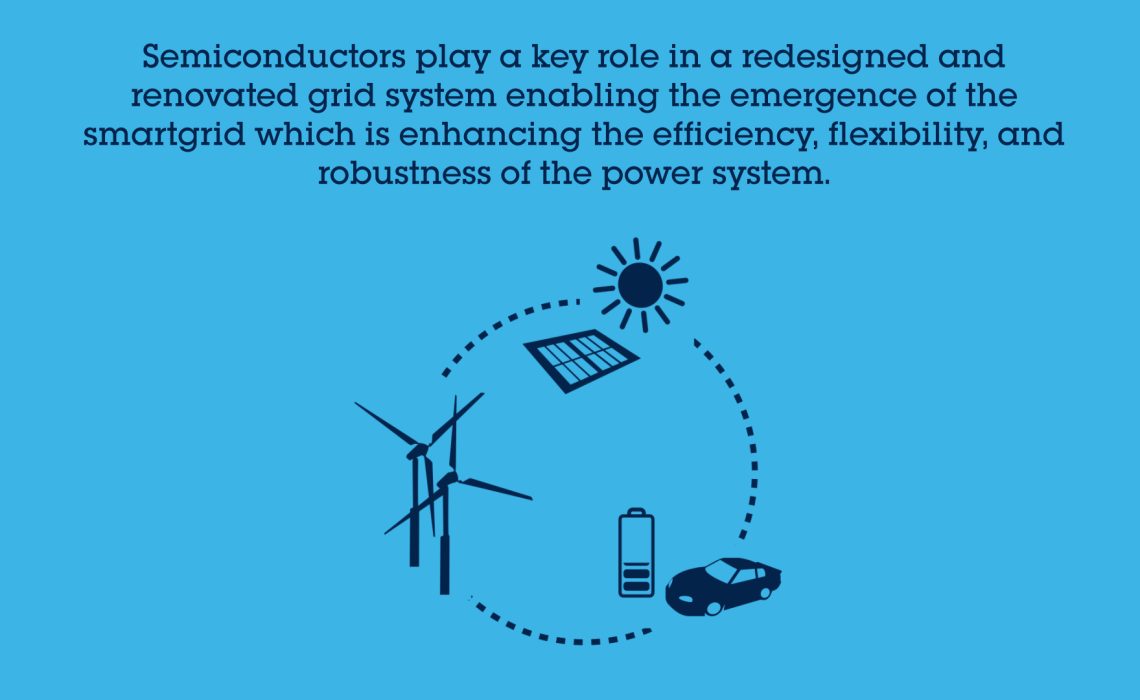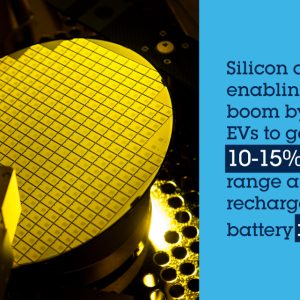How power is generated and distributed is changing. The emergence of smart grid technology is facilitating the integration of renewable energies and energy storage to the electrical grid which had not significantly changed in over 100 years. Semiconductor technologies are at the forefront of this move to a smart grid. They are helping improve information shared about electricity use between utilities and customers, and the grid and its operators. And they enable the grid to become more responsive to manage power supply and demand more efficiently.
The formation of an Internet of Energy
The essential feature of a smart grid architecture is that energy can flow both out of and into the grid. Every node in the network potentially functions as a source (providing electricity) or a sink (consuming electricity). A smart grid node could, for example, have a solar panel incorporated. When the sun is not shining brightly enough, then the node is dependent on the grid to make up the shortfall automatically. In contrast, when excess power is produced via the node’s solar resource, the grid can siphon it away, making it available to other nodes. There may be a battery reserve at the node, where energy can be stored for later use. By using local semiconductor-based intelligence, the operation of this battery reserve can be managed – so that energy is taken from or put back into the grid accordingly.
Implications of vehicle electrification
Due to ever greater numbers of electrical and electronic goods in the home, global consumption of electricity is increasing. On top of this, electric vehicle (EV) adoption naturally boosts electrical demand. EV charging points function as nodes on the smart grid. While EVs are being charged, they draw electricity for battery replenishment. They can also act as sources, with EV batteries supplying power to the grid when they are idle overnight. The smart grid allows EVs to become electricity resources through extensive digital communication between the grid and the EV batteries. In this way, EVs can provide many of the grid services that stationary energy storage systems can provide.
Grid stabilization
Electricity is transmitted over power lines in the form of an AC voltage at a certain frequency (usually 50 or 60Hz) in both the smart grid and the conventional grid. While the conventional grid generally featured only one power source, now there is a multitude of sources. It is vital that each source contributes power to the grid at the same frequency. They must also be perfectly in phase, so as not to cause a level of line instability that could potentially lead to a blackout. Thanks to the recent development of fast, powerful digital semiconductors, tremendous amounts of power carried on high power lines can now be controlled and modified instantly. Without this critical contribution, maintaining a constant frequency across the grid would not be possible.
Demand control
One of the key attributes of the smart grid is the ability to automatically enforce lower power consumption at a node. This is done when there is an elevated level of demand or, for example, when there is low availability of renewable energy. More electricity can then be delivered to the node when there is greater renewable power input available. Alongside this, battery storage helps to level out peaks in electricity, so stored energy can be used to offset restricted renewable input at any given time. Through these two mechanisms, it is possible to lower dependence on fossil fuels and enable renewable resources to play a greater role in power generation.
Helping customers make more sustainable choices
The new grid implementations being discussed are not just smarter for the electrical utility companies, rather they also allow consumers to become smarter too. Through smart meters, consumers are informed in real time about their consumption, about the cost of electricity, and the availability of renewable electricity, allowing them to modify their behavior. In this way, they can not only save money but can source their electricity from renewables.
Energy islands and microgrids
Groups of homes or businesses can join to form a microgrid, with only one access point to the smart grid. Pooling expensive assets, such as solar arrays and battery systems, save infrastructure costs. A microgrid arrangement can apply to larger company complexes, such as university campuses or hospitals too.
With local battery storage, there is less need for power that is sourced from the grid. This represents a tremendous contribution towards sustainability. Based on battery storage and renewable resources, a microgrid can function ‘off the grid’ as much as possible, thereby also placing less strain on the electrical distribution network.
Using digital devices to manage smart grid operation
The complex functionality of the smart grid requires a number of electronic components: sensors for the monitoring of critical parameters such as current, voltage, temperature, etc. Secure communication chips that feed data to control units, and microcontrollers in the control units, which can make real-time adjustments to smart grid functions.
The semiconductor components needed to implement many of these essential smart grid functions can often be combined. This more integrated system-on-chip (SoC) solutions are smaller and easier to implement than having numerous separate components. Often such SoCs incorporate complex algorithms to make the various subsections function in harmony with each other, increasing the efficiency of the grid.
The digital communication exchanges can also take place over the power lines themselves, to reach whatever grid node without the need for dedicated and costly communication infrastructure. The process is called power line communication (PLC).
STMicroelectronics is a leading producer of PLC modems, supplying the core technology behind smart grid deployments. ST is also a major producer in wireless communications and is pioneering the adoption of PLC and wireless hybrid solutions while exploring new emerging cellular (IoT) methodologies.
Sophisticated semiconductors address smart metering challenges
Indeed, ST draws on more than 20 years of experience improving efficiency along the whole energy chain from power generation to distribution and consumption. ST offers a complete set of solutions for power line communications that optimize power delivery and facilitate two-way communication across the grid, enabling end-user energy management, minimizing power disruptions, and transporting only the required amount of power. ST also offers smart metering solutions for energy, water, heat, and gas. Over 150 million smart meters deployed worldwide feature ST’s semiconductor devices and ST is actively contributing to all the major industrial and standardization smart grid initiatives.
Governments and power companies across the world have recognized that the traditional grid must be replaced by more efficient, flexible, and intelligent energy distribution networks. The result will be lower costs to the utility company and the customer, more reliable power, and reduced carbon emissions.
- Introduction: Semiconductors: Accelerating Society’s Transition to Greener, Smarter Systems
- Semiconductors and the Clean Energy Revolution
- How Semiconductor Technology is Accelerating Electrical Vehicle Growth
- Mitigating the Environmental Impact of Data Centers
- Semiconductors: Powering Electric Motors Efficiently
- Redefining the Electrical Grid with Semiconductors
- Using Edge Computing to Save Energy and Enhance Sustainability
- Making Offices, Homes, and Residential Buildings More Energy Efficient with Smart Technology





